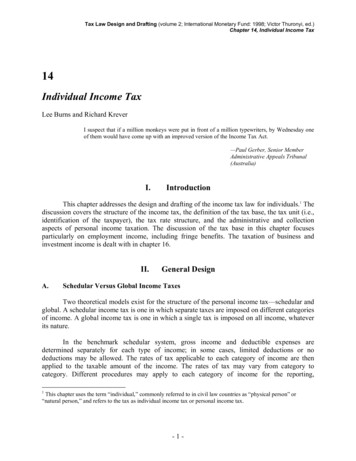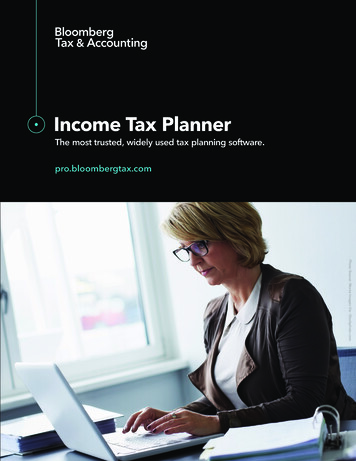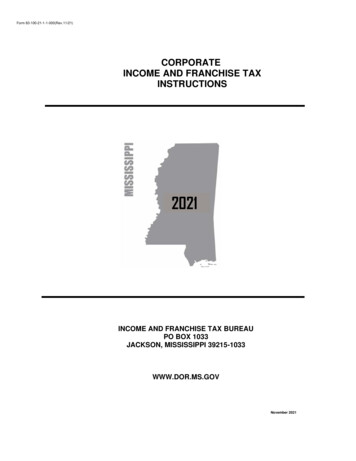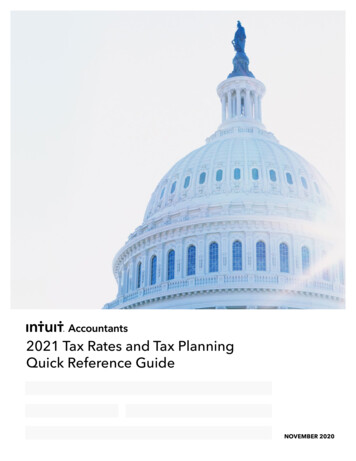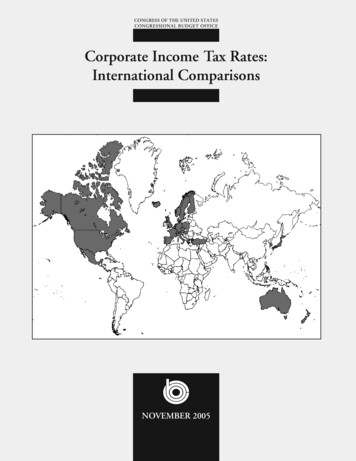
Transcription
CONGRESS OF THE UNITED STATESCONGRESSIONAL BUDGET OFFICECorporate Income Tax Rates:International ComparisonsNOVEMBER 2005
ACBOPA P ERCorporate Income Tax Rates:International ComparisonsNovember 2005The Congress of the United States O Congressional Budget Office
PrefaceCorporate income taxes can distort the allocation of productive resources both withinthe United States and across countries. This Congressional Budget Office (CBO) paper—prepared at the request of the Chairman of the House Committee on Ways and Means—examines the ways in which the corporate tax can distort economic behavior and shift resourcesamong alternative uses in ways that reduce overall well-being in the United States. The analysis compares statutory and marginal corporate income tax rates between 1982 and 2003 acrossa broad range of countries. In keeping with CBO’s mandate to provide objective, impartialanalysis, this report makes no recommendations.William Randolph of CBO’s Tax Analysis Division wrote the paper under the direction ofRoberton Williams and Thomas Woodward. Marika Santoro and Doug Hamilton of CBOprovided helpful comments, as did James Hines of the University of Michigan and KevinHassett of the American Enterprise Institute. (The assistance of external participants impliesno responsibility for the final product, which rests solely with CBO.)Leah Mazade edited the paper, and Janey Cohen proofread it. Denise Jordan-Williams prepared early drafts of the text, tables, and figures. Maureen Costantino designed the coverand prepared the report for publication. Lenny Skutnik produced the printed copies, andAnnette Kalicki and Simone Thomas prepared the electronic version for CBO’s Web site(www.cbo.gov).Douglas Holtz-EakinDirectorNovember 2005
CONTENTSSummary and Introduction ix1Analyzing the Distorting Effects ofCorporate Income Tax Systems 1Domestic Distortions 1International Distortions 52Comparing the United States’ Corporate IncomeTax Rates with Those of Other Countries 11The Structure of Corporate Income Taxes 11Statutory Corporate Tax Rates 14Effective Marginal Corporate Tax Rates 15
VICORPORATE INCOME TAX RATES: INTERNATIONAL COMPARISONSTablesS-1.2-1.Taxes on Corporate Income in OECD Countries in 2002as a Percentage of Gross Domestic ProductxTaxes on Corporate Income in OECD Countries in 2002as a Percentage of Gross Domestic Product13Figures2-1.Top Statutory Corporate Tax Rates in All OECD Countries, 2003222-2.Gross Fixed-Capital Formation in OECD Countries, 2003232-3.OECD Countries’ Top Statutory Corporate Tax RatesRelative to Total Investment, 200324Top Statutory Corporate Tax Rates in Selected OECDCountries, 200325Top Statutory Corporate Tax Rates in the United StatesCompared with Summary Measures of Top StatutoryRates for Selected OECD Countries26Top Statutory Corporate Tax Rates in the United StatesCompared with Summary Measures of Top StatutoryRates for the Other G7 Industrialized Countries27Present Value of Depreciation Deductions for Investments inMachinery in Selected OECD Countries, 200328Relationship Between Top Statutory Corporate Tax Rates andDepreciation Deductions for Investments in Machineryin Selected OECD Countries, 200329Depreciation Deductions for Investments in Machineryin the United States Compared with Summary Measuresof Depreciation Deductions for Selected OECD Countries30Present Value of Depreciation Deductions for Investmentsin Machinery in Selected OECD Countries Based onActual Inflation, 200331Depreciation Deductions for Investments in Machineryin the United States Based on Actual Inflation Comparedwith Summary Measures of Depreciation Deductionsfor Selected OECD Countries32Present Value of Depreciation Deductions for Investmentsin Industrial Structures in Selected OECD Countries, 2003332-4.2-5.2-6.2-7.2-8.2-9.2-10.2-11.2-12.
CONTENTSFigures .2-21.2-22.2-23.Depreciation Deductions for Investments in Industrial Structuresin the United States Compared with Summary Measuresof Depreciation Deductions for Selected OECD Countries34Effective Marginal Corporate Tax Rates for Equity-FinancedInvestments in Machinery in Selected OECD Countries, 200335Effective Marginal Corporate Tax Rates for Equity-FinancedInvestments in Machinery in the United States Comparedwith Summary Measures of Effective Marginal Tax Ratesfor Selected OECD Countries36Effective Marginal Corporate Tax Rates for Equity-FinancedInvestments in Machinery in the United States Comparedwith Summary Measures of Effective Marginal Tax Ratesfor the Other G7 Industrialized Countries37Effective Marginal Corporate Tax Rates for Equity-FinancedInvestments in Machinery in Selected OECD CountriesBased on Actual Inflation, 200338Effective Marginal Corporate Tax Rates for Equity-FinancedInvestments in Machinery in the United States Based onActual Inflation Compared with Summary Measures ofEffective Marginal Tax Rates for Selected OECD Countries39Effective Marginal Corporate Tax Rates for Equity-FinancedInvestments in Machinery in the United States Based onActual Inflation Compared with Summary Measures ofEffective Marginal Tax Rates for the Other G7Industrialized Countries40Effective Marginal Corporate Tax Rates for Equity-FinancedInvestments in Industrial Structures in Selected OECDCountries, 200341Effective Marginal Corporate Tax Rates for Equity-FinancedInvestments in Industrial Structures in the United StatesCompared with Summary Measures of Effective MarginalTax Rates for Selected OECD Countries42Effective Marginal Corporate Tax Rates for Equity-FinancedInvestments in Industrial Structures in the United StatesCompared with Summary Measures of Effective MarginalTax Rates for the Other G7 Industrialized Countries43Tax-Exclusive Effective Marginal Corporate Tax Rates forDebt-Financed Investments in Machinery in SelectedOECD Countries, 200344VII
VIIICORPORATE INCOME TAX RATES: INTERNATIONAL COMPARISONSFigures (Continued)2-24.2-25.Tax-Exclusive Effective Marginal Corporate Tax Rates forDebt-Financed Investments in Machinery in the United StatesCompared with Summary Measures of Effective MarginalTax Rates for Selected OECD Countries45Tax-Exclusive Effective Marginal Corporate Tax Rates forDebt-Financed Investments in Machinery in the United StatesCompared with Summary Measures of Effective MarginalTax Rates for the Other G7 Industrialized Countries46Data and Methods for CBO’s Analysis12Box2-1.
Summary and IntroductionThe corporate income tax is a significant part of theUnited States’ tax system. Federal corporate income taxrevenues in 2004 were 189.4 billion, or 1.6 percent ofgross domestic product (GDP).1 Federal plus state corporate income tax revenues in 2004 totaled 225.8 billion,or 2.1 percent of GDP. Corporate income taxes are also amajor source of revenues in other countries. For membersof the Organization for Economic Cooperation and Development (OECD), corporate income tax revenues in2002—the most recent year for which data are available—averaged 3.4 percent of GDP (see Summary Table1).2 Like all taxes, the corporate income tax may distorteconomic decisions and reduce economic well-being.The choices that each country makes about its corporatetax structure are significant for two reasons. First, the corporate tax distorts domestic economic behavior, as investors respond to the incentives that the tax creates. Thosepurely domestic distortions may occur regardless of howother countries structure their tax systems. Second, corporate tax systems in different countries interact with oneanother to distort decisions about international investment and to invite additional kinds of costly international tax planning. Concern about the potential for suchinternational distortions provides a rationale for comparing different nations’ corporate tax systems—the focus ofthis Congressional Budget Office (CBO) paper.tries. The comparisons themselves are presented in Chapter 2. Highlights of CBO’s analysis include the following:BThe domestic distortions that the corporate income tax induces are large compared with the revenues that the tax generates. That finding isindependent of how the United States’ corporateincome tax compares with the taxes imposed byother countries. The corporate income tax in theUnited States generates a variety of domestic economic distortions that may have little relationship towhat other countries do with their corporate incometaxes. Those domestic distortions bring about reductions in economic efficiency that researchers estimateare large relative to the amount of revenues that arecollected.3 Reforms to the tax system that reducedthose distortions would not depend on how theUnited States’ corporate tax rate ranked in relation tothe rates of other countries.BDifferences among countries in their corporate income tax structures distort incentives for locatinginvestments and create additional opportunities fortax planning. In addition to distorting firms’ decisions about domestic investment, corporate incometaxes may distort their international economic decisions. Costs to efficiency may arise because countriesimpose varying tax rates on corporate income, whichmay influence where and for what purpose a corporation chooses to invest. Those differential rates maydistort the international allocation of investment andcause businesses to engage in additional costly international tax planning.BAn international comparison of corporate incometaxes should account for differences among countries. The size of a country’s economy as well as itsCBO presents the analytical context for such comparisons in Chapter 1 and discusses how corporate incometaxes may distort economic incentives, both domestic andinternational. It also examines several features of corporate tax systems to show how corporate tax rates in theUnited States differ from those in other OECD coun1. For comparison, federal revenues from the individual income tax(excluding payroll taxes) in 2004 were 809 billion, or 7.0 percentof GDP.2. Because that figure includes both national and subnational (forexample, county or provincial) tax revenues, it is most comparableto U.S. state plus federal corporate income tax revenues.3. Economic efficiency generally is the extent to which a given set ofresources is allocated across uses or activities in a manner thatmaximizes whatever value they are intended to produce.
xCORPORATE INCOME TAX RATES:INTERNATIONAL COMPARISONSSummary Table 1.other economic characteristics influences the corporate tax rate that a country establishes. Consequently,an analysis of tax-rate differentials should recognizethe ways in which countries vary. For example, comparing corporate income taxes in the United Stateswith those of other large industrialized countries maybe more revealing than comparing the United States’corporate tax structure with the structures of muchsmaller and less industrialized countries.Taxes on Corporate Income in OECDCountries in 2002 as a Percentage ofGross Domestic ProductCountryAustriaAustraliaBelgiumCanadaCzech elandIrelandItalyJapanRepublic of KoreaLuxembourgMexicoNetherlandsNew ZealandNorwayPolandPortugalSlovak RepublicSpainSwedenSwitzerlandTurkeyUnited KingdomUnited StatesUnweighted averageWeighted averagePercentage of rce: Congressional Budget Office based on Organization forEconomic Cooperation and Development, Revenue Statistics of OECD Member Countries (Paris: Organization forEconomic Cooperation and Development, 2004), Table 12.Notes: Percentages include both national and subnational taxes oncorporate income.* data not available.BBoth statutory corporate tax rates and effectivemarginal corporate tax rates affect economic incentives. The full effect of statutory corporate income taxrates, rules for depreciation of productive assets, andother features of the tax code—as they determine effective marginal corporate tax rates—influences wherecorporations choose to invest.4 For certain other costlytypes of international tax planning, the most important factor is differences among countries in their statutory tax rates alone.As a consequence, statutory and effective marginal taxrates in the international context have both combinedand separate importance to corporate tax policy. For acountry starting out with relatively high effective marginal and statutory tax rates, corporate tax cuts in theform of, for example, larger allowances for depreciation of equipment and structures will reduce effectivemarginal rates and attract more investment. But suchcuts will not reduce the type of corporate tax planningaimed at taking advantage of the differences in countries’ statutory corporate tax rates. The incentives forthat kind of activity can be diminished—and investment attracted—by adopting depreciation rules thatmore closely approximate economic depreciation andcombining them with lower statutory rates.5BAlthough the United States’ statutory corporate taxrates are among the highest of those in OECDcountries, they are comparable with the statutory4. An effective marginal corporate tax rate is the percentage of theincome from a marginal investment that must be paid as corporate income taxes. An investment is considered marginal when itpays just enough income to make the investment worthwhile.5. Economic depreciation is what is generally meant by the term“depreciation”—that is, the decrease in the value of a productiveasset that occurs because the asset provides less remaining productivity as it ages. By contrast, tax depreciation is the depreciationallowed by the tax code.
SUMMARY AND INTRODUCTIONCORPORATE INCOME TAX RATES:INTERNATIONAL COMPARISONSrates imposed by other members of the Group ofSeven (G7).6BHow effective marginal corporate tax rates in theUnited States compare with other countries’ ratesdepends on the type of corporate investment beingmade and the way in which it is financed. Corporate investments are financed by either shareholders orlenders (which include corporate bondholders). Compared with the average effective marginal corporate taxrates for shareholder-financed investment in machinery among all other OECD countries, the UnitedStates’ rate is slightly higher; compared with the average among other G7 countries, the United States’ rateis about the same. Compared with the average rate forshareholder-financed investment in industrial structures among all other OECD countries, the UnitedStates’ rate is significantly higher; however, the UnitedStates’ rate is close to the average among other G7countries. In contrast to rates for shareholder-financedinvestment, the United States’ effective marginal corporate tax rate for lender-financed investment in ma-6. The G7 industrialized countries are Canada, France, Germany,Italy, Japan, the United Kingdom, and the United States.chinery is low by comparison with the average forother OECD countries and for other G7 countries.From an international perspective, although theUnited States’ effective marginal corporate rates forshareholder-financed investments are higher than theaverage, such rates for investments financed by a combination of shareholders and lenders may be lowerthan the average if a sufficient fraction of the marginalinvestment is financed by lenders.BThe history of corporate tax rates between 1982and 2003 suggests that countries do not changetheir corporate tax rates independent of one another. After large reductions in statutory corporate taxrates by Ireland, the United Kingdom, and the UnitedStates in the mid-1980s, other OECD countries alsocut their rates, perhaps out of concern that they wouldlose investments or part of their tax base—for example, when corporations moved their operations to alower-tax country. Hence, the corporate tax rates thatthe United States establishes may affect the choicesthat other countries make about rates. Thus, how theUnited States’ corporate tax rate ranks in relation tothe rates in other countries is not determined by U.S.policy choices alone.xi
CHAPTER1Analyzing the Distorting Effects ofCorporate Income Tax SystemsTaxes—including corporate income taxes—distortincentives, primarily by taxing endeavors unevenly. Whentwo kinds of economic activity are taxed at different rates,the more highly taxed activity tends to diminish and theless heavily taxed activity expands. Once economic activity takes on a pattern that is based on tax rates, resourcesin the economy are misallocated and inefficiency results,as economic activity shifts away from its most valuableopportunities.In spite of its potential to distort economic behavior, thecorporate income tax exists in part because it is administratively less costly to collect some taxes on income at thelevel of the firm rather than at the level of the individual.Corporations frequently distribute only some of theirprofits to creditors and shareholders; they retain the restfor reinvestment. Those reinvested profits typically increase the value of the firm and represent income forshareholders in the form of capital gains—that is, gains inthe value of shareholders’ ownership shares. Althoughsuch capital gains may eventually be taxed, only profitsthat are distributed as interest to lenders or dividends toshareholders are considered cash flows, which are subjectimmediately to taxation under the individual income tax.Thus, in part to fully tax all profits, the United States’ taxsystem subjects a corporation’s profits to their own income tax.1That arrangement has the advantage of bringing incomethat the corporation retains into the tax system. But theapproach may go too far when it distorts economic incentives for investment by taxing some corporate earningstwice, first at the corporate level and then as income re1. Using the corporation to withhold other taxes—for example,income and payroll taxes—may also confer advantages, but analysis of those levies is beyond the scope of this report.ceived by individual taxpayers. Policymakers could endthe double levy by simply eliminating the corporate tax;doing so, however, would introduce new distortions byfavoring corporations that did not distribute profits butrather accumulated and reinvested them. Moreover, someof the distortions that the corporate income tax causes areinherent to the taxation of capital income in general. Toeliminate the distortions specific to the corporate incometax would require integrating the corporate and individual income taxes.2Serious concern about the corporate income tax springsfrom the ways in which it distorts economic incentivesboth at home and abroad. The result of such distortionsis that resources are not allocated to their best uses andthus cannot yield their fullest benefits to society.Domestic DistortionsAt a purely domestic level, the corporate income tax hasthe potential to distort economic incentives and generateinefficiency in at least six ways. First, because it is imposed on income from capital, it biases individuals’ decisions about how much to save and can therefore influenceoverall capital investment and economic growth. Second,because the corporate income tax is imposed only onsome kinds of business profits (in the United States, typically those of corporations that have many shareholders)and not on others (such as the profits of partnerships andsole proprietorships), it affects the ways in which businesses are organized and creates biases in investment and2. See Richard M. Bird, “Why Tax Corporations?” Working PaperNo. 92-2, prepared for the Technical Committee on Business Taxation (Ottawa: Department of Finance, 1996); and U.S. Department of the Treasury, Integration of the Individual and CorporateTax Systems (January 1992).
2CORPORATE INCOME TAX RATES: INTERNATIONAL COMPARISONSproduction toward those types of business structuresthat are not subject to the corporate income tax. Third,it creates a bias in corporate financing toward the useof debt—because the tax is imposed on income fromequity-financed investment and not on the return todebt-financed investment. Fourth, because the law treatsa corporation as a separate taxable entity from whichshareholders subsequently realize income in the form ofeither dividends or capital gains, the relatively beneficialtax treatment of capital gains under the individual income tax creates a bias toward them and against the payment of dividends. Fifth, because the United States leviescorporate income tax on the basis of schedules for depreciation that do not correspond to economic depreciation,it taxes different kinds of assets and industries at differenteffective rates, creating a bias in investment and production toward the more lightly taxed assets and sectors. Finally, the corporate income tax may distort the allocationof resources by making corporations’ compliance withtaxation costly and by creating additional opportunitiesfor tax planning.3Saving and InvestmentThe corporate income tax is part of the broader taxationof income from capital. Consequently, it may affect capital investment through its effects on both the supply ofand demand for capital. The corporate income tax mayaffect the supply of capital by reducing the returns thatindividuals receive from saving. It may affect the demandfor capital by changing what businesses must pay to acquire capital for investment.Saving by Individuals. Saving is income that is not currently consumed. Saving is positive when individualsconsume less than their current income to finance theirfuture consumption. It may be negative if individualsconsume more than their current income, either borrowing or using accumulated wealth to finance their currentconsumption. Taxes on income from capital introduce abias into the incentives for saving because they make consumption in the future relatively more expensive thanconsumption today. Thus, such taxes may alter when anindividual chooses to consume (although whether thosetaxes increase or decrease saving is uncertain because it isthe temporal decision that they affect). For example, in3. See Jane G. Gravelle, The Economic Effects of Taxing CapitalIncome (Cambridge, Mass.: MIT Press, 1994), pp. 75-93, for asurvey of the literature on the domestic efficiency costs of the corporate income tax.the face of taxes on capital income, an individual who decides to keep future consumption at a fixed level mustsave more and consume less now. Alternatively, the sameindividual could decide to save less now and also consume less in the future.The net effect of capital income taxes on how much individuals save therefore depends on two offsetting factors.First, such taxes reduce the after-tax rate of interest that asaver (or investor) receives and thus decrease the price ofcurrent consumption relative to future consumption.That decrease in the relative price tends to cause peopleto increase their current consumption and save less (the“substitution effect”). Second, capital income taxes maydecrease current consumption or future consumption, orboth, by making less income available for consumptionboth now and in the future (the “income effect”). The income effect may lead people to respond to capital incometaxes by consuming less now (and in the future) and saving more. Whether the overall effect of capital incometaxes is to cause people to save less or more depends onwhether the substitution effect is stronger or weaker thanthe income effect—and that depends on peoples’ preferences and can only be determined by empirical investigation.A variety of empirical studies have tried to measure thenet effect on saving of changes in the rate of interest, butthe results have been inconclusive.4 No researcher hasmade a compelling case that a significant net effect existsin either direction. However, the shortcomings of thestudies and of the data they use are such that a realisticchance remains that taxes on capital income affect saving.Investment by Businesses. How the corporate income taxaffects businesses’ demand for capital is less ambiguous:the tax diminishes the demand for capital in the corporate sector by increasing the cost of capital (the before-taxrate of return that is just high enough for an investmentto be funded). A business will undertake a particular investment only if the business expects to earn a before-taxrate of return that is high enough to satisfy its financialinvestors after taxes are paid; otherwise, the investors willsupply their funds elsewhere. The corporate income taxincreases the cost of capital by driving a wedge between4. See B. Douglas Bernheim, “Taxation and Saving,” in Alan J. Auerbach and Martin Feldstein, eds., Handbook of Public Economics,vol. 3 (Amsterdam: North-Holland Press, 2002), pp. 1173-1249,for a survey of the literature on the effects of taxation on saving.
CHAPTER ONEANALYZING THE DISTORTING EFFECTS OF CORPORATE INCOME TAX SYSTEMSthe after-tax return that investors demand and the pretaxreturn that a business’s investment must earn to pay bothtaxes and investors.tor (because the tax has raised their cost of capital). Thus,the corporate income tax tends to distort productionwithin both sectors by decreasing production in the corporate sector and increasing it in the noncorporate sectorand by changing the ways in which those sectors use capital assets in production.Organizational FormThe United States’ tax system does not subject all business activity to the corporate income tax. Unincorporatedbusinesses, such as sole proprietorships and partnerships,do not pay the tax. Instead, all of their income, whether itis distributed to owners as dividends or retained for additional internal investment, is “passed through” and taxedonly at the level of the individual—that is, the owner orowners. In the United States, some corporations mayelect treatment under subchapter S of the corporate income tax, which allows them the same kind of passthrough arrangements that the tax code permits unincorporated firms.5 Pass-through treatment is also available toreal estate investment trusts and to mutual funds that areorganized as regulated investment companies. Limited liability companies (LLCs) are another form of business organization. Although practically indistinguishable fromcorporations, LLCs are not subject to the corporate income tax because technically they are not incorporated.The fact that different types of organizations are taxeddifferently creates a bias against organizing as a corporation, which is subject to the corporate income tax, and anincentive for businesses to organize in noncorporateforms that are not subject to the tax. But the extent ofthose effects goes beyond a shift by some businesses to adifferent organizational form. Not all industries lendthemselves to the noncorporate structure. The corporateform is particularly prevalent among industries that uselarge quantities of capital drawn from many investors.Consequently, the bias against the corporate form alsobecomes a bias against some industries and types of production. To the extent that the corporate tax lessens thedemand for capital in the corporate sector, it makes moreof that capital available for investment in the noncorporate sector. However, the overall efficiency of investmentwill be reduced if businesses invest that capital within thenoncorporate sector even when those investments providea lower pretax rate of return than do other potentiallybetter investments forgone by firms in the corporate sec5. Tax law requires that S corporations be structured in such a waythat it is administratively easy to tax them as pass-through entities.Thus, an S corporation must be a purely domestic corporationthat issues only one class of stock to no more than 75 shareholders.FinancingBusinesses may finance investment either by selling ownership shares, or stock (equity), or by borrowing (debt). Iffirms choose equity financing, investors realize returns inthe form of residual profits—that is, the profits that remain after the business pays all of its creditors and suppliers. If businesses finance investment through debt, investors receive their returns as interest. The corporateincome tax may distort a business’s decisions about financing because the tax is imposed only on residual profits; it is not imposed on the income a firm pays as interestto investors (because such interest is deductible from thefirm’s taxable corporate income). As a result, the tax creates a bias in favor of debt financing, and corporations arelikely to be more heavily financed by debt than theywould have been without the corporate income tax. Thatgreater dependence on debt financing may increase thechance that companies will not be able to pay their creditors, thus heightening the risk of bankruptcy.6 Further,shareholders, creditors, and managers have divergent interests that are partly balanced by each company’s chosenmix of debt and equity financing. The corporate incometax may upset that balance by encouraging firms to usetoo much debt.7DividendsAfter a corporation pays the interest owed to its creditors,it may distribute its residual profits to its shareholders asdividends, use the profits to repurchase shares from shareholders, or retain those profits for reinvestment. In eachcase, the profits become income of the shareholders; how6. See Roger Gordon and Burton Malkiel, “Corporation Finance,”in Henry J. Aaron and Joseph A. Pechman, eds., How Taxes AffectEconomic Behavior (Washington, D.C.: Brookings Institution,1981), pp. 131-198.7. See Michael Jensen, “Agency Costs of Free Cash Flow, CorporateFinance, and Takeovers,” American Economic Review Papers andProceedings, vol. 76 (May 1986), pp. 323-329. See Alan J. Auerbach, “Taxation and Corporate Financial Policy,” in Auerbach andFeldstein, Handbook of Public Economics, pp. 1252-1292, for asurvey of the literature on how taxation affects corporate financialdecisions.3
4C
VI CORPORATE INCOME TAX RATES: INTERNATIONAL COMPARISONS Tables S-1. Taxes on Corporate Income in OECD Countries in 2002 as a Percentage of Gross Domestic Product x 2-1. Taxes on Corporate Income in OECD Countries in 2002 as a Percentage of Gross Domestic Product 13 Figures 2-1. Top Statutory Corporate Tax Rates in All OECD Countries, 2003 22


